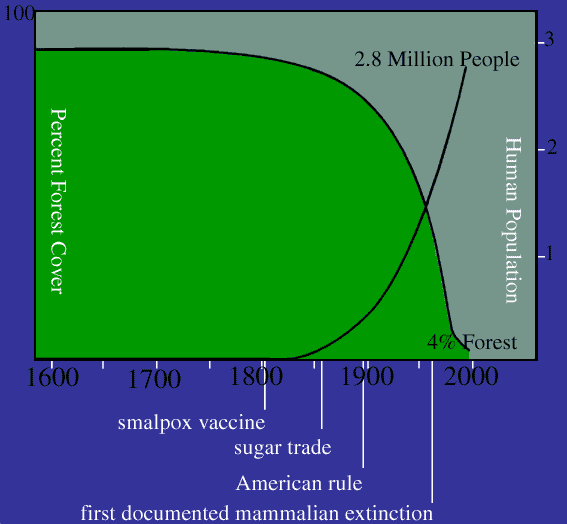Negros Island
A Case Study in Deforestation, pt 1
This site is under redevelopment. Its content is from 1998, but we will be updating it in the near future.
Destruction of rain forest is not inevitable, and it is not a requirement of "progress." In the long run, it is seldom defensible in economic or social terms, since it usually represents a net loss for the great majority of the people who live in the area, and also a great loss for the plants and animals involved. And yet it has happened rapidly in the Philippines, bringing challenges that we did not anticipate and for which we seem poorly prepared.
The magnitude of these social, economic, and environmental issues is daunting; a comprehensive understanding of the process of forest destruction as it has unfolded for the entire nation would require more time, space,and knowledge than we have available in this website. Taking a single island as an example seems the best way to bring the issues surrounding deforestation to a manageable scale. We have chosen Negros Island, near the center of the Philippines, as our case study, not because it is exceptional, but rather because in most respects it is quite ordinary—an ordinary example of biotic and environmental devastation.
When the Spanish conducted first census of Negros Island in the early 1600s, the population was about 25,000, as it probably had been for centuries. Most of the inhabitants lived in small villages along the coast, especially near the mouths of the few small rivers. Hunters often hiked the short distance to the mountains (less than a one-day journey) to set snares for wild pig and deer, and fisherfolk slashed and burned small clearings in order to grow vegetables and medicinal plants for a few years. With the rain-catching mountains rising to about 2,000 meters in both the north and the south, rivers from the peaks always carried water, even when the dry season stretched to three or four months.
For the next two hundred years, little changed on Negros Island. In the early 1800s, censuses showed at most 30,000 people, and only a little more land had been cleared along the fertile west coast. But by 1850, external factors began to change conditions dramatically.
The first of these factors was the first arrival of modern medicine, especially the smallpox vaccine. Brought across the Pacific Ocean from Mexico as liveculture in orphaned boys, the vaccine had an immediate impact. Previously, smallpox had swept through the villages on Negros every three to five years, often killing a quarter or more of the young children. With the vaccine, mortality dropped dramatically, causing the first upswing in population growth in centuries. Other medicines arrived soon after, allowing more people to live to the age at which they, too, could produce families.
A second factor with even greater and more far-reaching impact was the arrival of large-scale export-based plantation agriculture, especially sugar cane. Tobacco, manila hemp, and cotton had been cultivated on huge haciendas elsewhere in the Philippines since the 1700s, but it was only with the boom in sugar prices in the 1850s that wealthy landowners from Panay began developing operations on Negros. Thefertile western plains were quickly cleared of prime lowland rain forest, as were smaller areas on the east coast. Workers from Negros joined immigrants from the more densely populated neighboring islands of Panay and Cebu in the swelling ranks of those planting and cutting cane.
Until the development of petroleum-powered machinery, export-based plantation agriculture depended entirely on the supply of human hand-labor. Then as now, the price of a given product—sugar in this case—was determined globally based on competition between producers for the lowest price (except in the case of subsidies, which are discussed below). Various mechanisms were developed in different parts of the world to assure a ready supply of the material most critical to competitiveness on the world market—cheap human labor. In the Western Hemisphere, the mechanism wasoften slavery, involving mostly transplanted Africans; in Europe, it was serfdom, peasantry, or something similar. The Spanish in the Philippines developed a system that was similar to serfdom, although without the formality of a titled landed gentry.
In this system, the colonial government sold or gave as a reward for service, large tracts of land to certain individuals. The people whose families had lived in the area for generations were required to provide labor for a brief portion of each year as a form of taxation. Initially this system operated on a small scale, but as the export market grew, little good land remained for small farmers, and so more local people chose to work in the fields for wages. With the advent of large-scale sugar cane production on Negros Island, great numbers of workers were brought from other islands specifically to work the fields; they helped to keep the price of labor low, and were especially dependent on the landowners for their survival. The combination of low wages and high prices for food and clothing locked workers into a cycle of dependency exacerbated by their need for cashloans from the landowners during the seasons when there was no work.
Educational opportunities for plantation workers were minimal, and in a society made up only of the wealthy landowners, a small merchant class, and a large population of people who worked in the fields and kept small subsistence farms in the nearby hills, there were almost no opportunities for other employment. Virtually the only means at hand to increase the family's income was to produce more children to work on the plantations. Furthermore, the only security in old age lay in those same children; indeed, virtually the only valuable "possession" of such people was their family. And so people produced large families in an attempt to secure their individual futures, but in the process they guaranteed a supply of the most valued commodity in aplantation-based society—abundant, cheap human labor. By the late 1800s, the population on Negros Island had climbed from 25,000 to about 500,000 people.
The third influential factor in contributing to swift and massive change in the lives of people on Negros was the installation of the American colonial government in 1898. After fighting one of the bloodiest wars in its history in suppressing the independence movement and taking control of the Philippines, the United States colonial government built new schools and clinics and increased the amount of business activity, thereby creating new sources of employment. It also granted concessions to logging companies, encouraging them to cut new roads into the interior forests of Negros and other islands, opening the land to logging and then to a steady stream of workers leaving the plantations to findfarmland of their own. Plantation agriculture was further expanded and intensified as the colonial government sought ways to generate foreign currency from exported raw materials and unprocessed foodstuffs. Lumber companies operating on Negros cut the remaining prime lowland forest before moving on to other islands to do the same. The result was swelling population and reduced forest cover.
Part 2: http://philippines-dev.fieldmuseum.org/natural-history/narrative/4799

